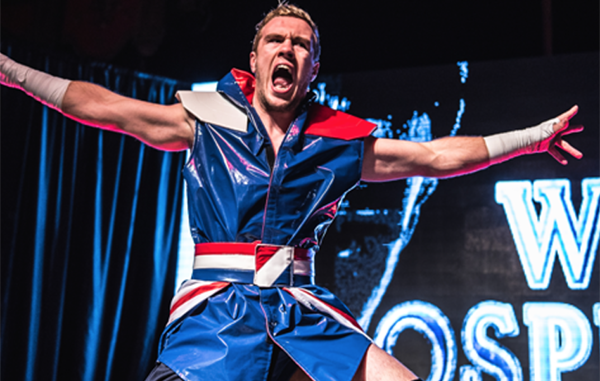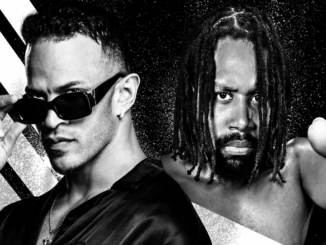
SPOTLIGHTED PODCAST ALERT (YOUR ARTICLE BEGINS A FEW INCHES DOWN)...
If you’re feet have been feeling a bit chilly recently, it may be because Billy’s documentary has finally been released. The long-trailed documentary about Will Ospreay, which secured funding all the way back in 2016(!), was unceremoniously dumped onto Amazon Prime on Friday, November 21, 2020.
The only announcement was a rare tweet from the usually illusive filmmakers explaining that, given the issues surrounding Speaking Out, they no longer felt comfortable monetizing the product (beyond of course receiving over £15,000 in crowdfunding, much of which presumably paid for them to fly to Tokyo (once, maybe twice) and so were not charging for the film, and would donate any advertising revenue they did generate through Prime to a charity dedicated to the victims of sexual violence and abuse.
So far, fair enough. The truly bizarre claim was that they had edited the final documentary to remove those who had been accused of misbehavior “Speaking Out.” If the film I watched was the edited cut, it truly beggars belief how many abusers were in the original version. Maybe there was a Jimmy Saville cameo they thought better of. Because in the first six minutes of this version we get Marty Scurll (admitted to sexual activity with an intoxicated 16 year old who been sexually abused by their promoter) and Travis Banks (admitted to entering into a secret sexual relationship with an eighteen year old he had trained since she was sixteen) talking to camera.
Both are used throughout the rest of the movie as talking heads, Scurll extensively so. Later there’s similarly weird decisions, such as Fight Club: Pro’s then Co-Promoter Martin Zaki (admitted to being guilty of sexual misconduct with fans and ring crew) being filmed hugging Nixon Newell, in a fleeting shot that could easily have been scrubbed from a post-Speaking Out edit. Likewise it throughout revels in the boozy, informal culture that seemed such a thrill at the time, but was actually the platform for so much abuse.
There is however one small clue as to what those post-Speaking Out edits may have been. Whilst they haven’t restarted running shows, the one promotion who has made the most ostentatious display of distancing themselves from the pre-Speaking Out Britwres is Progress, even though their now sole owner and a former co-owner (who was also the public face/muse of the promotion) are happily working on a NXT UK that has resumed featuring several people accused in Speaking Out.
Coincidentally there is a weird moment towards the end, where a crowd shot outside the O2 Ritz Manchester, Progress’s home in Manchester, cuts to Marty Scurll talking to a RevPro crowd. RevPro have never run that venue. Maybe the cuts the filmmakers had to make were due to PROGRESS pulling permission for them to use footage shot at their shows, and this brief transition frame slipped through the cracks. Would explain why Ospreay’s seminal rivalry with Jimmy Havoc was completely absent from the documentary, whereas a random match at WCPW against Marty Scurll, and some locker-room talk with Travis Banks at the same show, made the cut.
Of course Speaking Out casts a shadow on Ospreay himself, with the events of the summer bringing a renewed focus to allegations he was involved in blacklisting a female pro-wrestler known as Pollyanna after she accused his friend Scotty Wainwright of raping her (inexplicably there is actually fleeting footage of Wainwright in the film). It’s impossible to talk about how the film interacts with that shadow, without first going into more detail about the film itself.
Better Never Than Late
This film may have missed more deadlines than I did during my entire time at Fighting Spirit Magazine, and as Brian Elliot will tell you, I missed a lot! You can tell that with the motley crew of promotions most of the footage is culled from, with deserved failures such as WCPW and 5-Star Wrestling being prominently featured.
The filmmakers access to these promotions loom large in the film, with them looking at any excuse to crowbar in interview clips they got from Jim Cornette and Cody Rhodes at WCPW’s debut in November 2016, and Rey Mysterio and John Morrison at 5-Star Wrestling’s first televised show in January 2017. The former is particularly bemusing to me, as I went to that show as press trying to get an interview with Cody Rhodes about his guest appearance on Arrow for a pop culture magazine, an endeavor I failed in. I did, however, get to tell Cornette about the “Access Hollywood” tape though, as he had missed the breaking news about Trump whilst flying to the UK.
YES! That’s how long ago key footage in this film is. And it doesn’t get much better than that.
The filmmakers clearly know the raw footage is hilariously out of date, and so repeatedly use deceptive editing practices to hide this. Whilst there’s a pretty tight focus on 2016 and 2017, the timeline of the film is a mess, with them clearly cutting backwards and forwards to obscure the fact that the British footage seemingly stops halfway through the second year. Like a demented toddler with a jigsaw they try to force ill-fitted pieces together, such as using a clip of Paul Levesque talking about the initial UK Title Tournament as a lead-in to a quick segment about Noam Dar and Big Damo (Killian Dane) signing with WWE, even though both had no involvement with said tournament.
The former is particularly galling, as WWE’s failure to get Ospreay for the Cruiserweight Tournament (which before the “revival” of WOS Wrestling was a thing saw WWE sink its claws into major Britwres indies through several qualifying matches) being a significant failure for Levesque’s brain trust, something which really needs to be covered by a documentary focused on this part of Ospreay’s career. Of course there’s much they don’t cover, including Ospreay launching his own promotion, in the explosive failure that was Lucha Forever, and the infamous match against Vader.
Likewise, it’s hard to know what to give credit to the filmmakers, or their ability to collate footage from other, more worthwhile content producers. For example, they include footage from an infamous Inside the Ropes event where Paul Heyman lords it over Ospreay by offering him a worse-than-worthless Evolve contract. Of course they cut that bit of the footage because even these filmmakers know it would look ridiculous, and instead focus on Heyman saying how great Ospreay is. But at no point do they acknowledge that it is not actually their interview. That then calls into the question the genuinely interesting interview clips we see from the Young Bucks, and particularly, Kenny Omega. Given they never once mention the words “Will Ospreay,” it seems fair to worry they’ve just grabbed some footage to pad out their documentary.
And pad out is the correct phrase. You may have noticed I’ve barely talked about Ospreay for the past 500 words, and I can assure that’s not by my design. This documentary is so unfocused that it’s basically two separate documentaries. There is the part of the documentary that explores the growth of Britwres in 2016 and 2017, and then there is the part that actually looks at Ospreay. Both are broadly given equal weight, which is a poor return for those who helped fund a documentary about their hero. Also, irritatingly, both feature tangents where they seem to be trying to manipulating their interviews with members of The Elite to hint at the rise of AEW, even though All In takes place over a year after the most recent events shown in the film.
The parts that look at Ospreay are actually reasonably informative, with insightful contributions from his family and childhood friends coupled with entertaining archive footage. There is something Rain Man-esque at how Ospreay at a young age could perform complex wrestling moves in his backyard or classroom. A particular highlight from the archive footage is the construction of the makeshift ring that replaced the trampoline he and his friends had been using. Ospreay’s parents’ explanation for how they came to construct the ring, is of a piece with their winsome if vainglorious contributions that emphasize that they were the only people who believed in their child’s wrestling dreams. It cannot be stressed how far the film goes to underline this point; like a Stalinist show trial they bring out Ospreay’s grandparents to admit that they were two of the disbelievers.
Their egotism aside, his parents are fascinating presences in the film, with their unvarnished contributions clearly at odds with the performers and fans featured throughout the film. The film does a poor job in placing their remarks into context. For example I’m sure many people rolled their eyes at Ospreay’s mum saying that between 70% and 80% of school children aren’t academically minded and need to get a practical job, without realising that she’s just stating the explicit policy of her county’s local government, with Essex being the most populous county in England to still have academic selection at the age of 11. A process that was once justified nationally as dividing young people into sheep and goats, and today In Essex only aims to give a fully rounded academic education to 25% of young people. My parents were similarly working class people who had succeeded in business to the point they could provide their children with a comfortable lifestyle, but having grown up in the county that was one of the first to abandon academic selection, I was thankfully spared such pervasive anti-intellectualism.
Once you understand that context, you see the unrelenting class warfare Ospreay faced. Denied the opportunity to explore academic pursuits at a young age, his artistic interests were repeatedly attacked by teachers trained to see him as somebody who could only be a laborer. His parents’ advocacy for him against a hostile educational establishment really does provide a natural arc for his story, with New Japan Pro Wrestling the stand-in for the Royal Ballet School, in this Southern version of Billy Elliot. But of course that is not a story that as many as people are interested in hearing as they were before Speaking Out.
What the film is not good at is explaining how he got into pro wrestling, with no attempt to talk to his trainers, nor explore the promotions he worked with as he learnt the business. Nor does it try to explain what makes Ospreay special as a pro wrestler. It’s common to complain about WWE’s documentaries complicated relationship with the truth, but what you can’t underestimate is the importance of their commitment to convey the basics. Because whilst you almost always need to read more trustworthy sources to get the full picture, a WWE retrospective will at least give you some idea about the trainers, signature moves, key rivalries and unique selling points of the performer their profiling. This documentary really doesn’t even try to do that, even when, as in the case of Scurll and Ricochet, they have access to both an interview with his opponent, and match footage. Other than the generally informative passages about his childhood, the only things the film tells you about Ospreay is his neck is messed up and he has gained confidence about interacting with Japanese fans…oh, and he’s arguably controlling around women.
C’est la vie
If anything demonstrates the strengths and weaknesses of Ospreay is its coverage of Nixon Newell (now better known as Tegan Nox in NXT, but called by her British stage name throughout the film). The strength is simply that seeing footage of Newell back in 2017 is undiluted nostalgia, where you can revisit a period before the Performance Centre repackaged her as a generic women’s wrestler and injuries laid waste to almost the entirety of the past three years. But of course its nostalgia in the “Don Draper-selling-Kodak” sense of the word, because we know the future is ahead of her. Yet a film that was released just now, pretends the past three years haven’t happened.
But the biggest problem is that there’s no good reason why Nixon Newell is featured so prominently in a documentary that is meant to be about Ospreay. Despite what the film implies, they weren’t regular tag team partners, indeed Cagematch has them down as only teaming once, which chimes with my recollection that their paths didn’t cross all that much given that back when Britwres was more regional, Ospreay was based in Southern England and Newell was primarily featured in promotions along the Midlands-South Wales axis. The only logical reason Newell was so prominently featured, was that she happened to be wrestling on one of the now long forgotten shows they filmed at. It’s notable that Newell doesn’t say much about him other than explaining how the punchline to an elaborate dance routine they did as tag partners was her taking a big bump, which now everyone else wants to replicate.
Worse, Ospeay comes off badly in these segments. When they cover the news she was moving to America for NXT. Ospreay reacts by crying about her leaving, talking about how of all the wrestlers in Britain he would tell NXT not sign her so she can gain more experience and do more things, whilst also claiming credit for being the one that sees a future Wrestlemania superstar in her.
It goes without saying that this is extremely odd. It’s not clear why he’s so upset Newell is leaving Britwres as compared to the various male pro wrestlers whose signing with WWE is mentioned in the documentary without comment from him, it’s not clear why he feels he has any right to suggest he should interfere with Newell’s career, and it’s not clear why he feels only he understands how great she is, when Newell was one of the most universally beloved fixtures on the British scene. It might be sloppy filmmaking, but this weird double standard is of a piece with him lashing out at Sadie Gibbs in 2019 over him believing she hadn’t been sufficiently diligent whilst on tour with Stardom. Whether he was right or wrong, and there was plenty of evidence to suggest he was wrong, there’s no good reason for him to be so possessive over young female wrestlers when he never acts the same way over men.
Let’s be honest about this documentary; they put it out with little fanfare because the alternative would be potentially having to give that £15,000 back to the original donors. The resulting film is a mess, with no analysis about Ospreay as a wrestler, and no serious attempt to talk about his greatest rivalries. What you have is about 30 minutes of strong content about his family and early life and around ten minutes of somewhat interesting footage of his initial trips to Japan interspersed with a misleading potted history of the Britwres Boom. Whilst everything else is a waste of time unless you want to be reminded about how fun Britwres was before the truth was revealed, the stuff on Ospreay’s childhood is genuinely interesting, if you can stomach the positive portrayal of someone who is very much a flawed and fallen hero.
Therefore I would give this film a Thumbs in the Middle, leaning down.
“OSPREAY” is available to watch for free on Amazon Prime in select markets.




Leave a Reply
You must be logged in to post a comment.